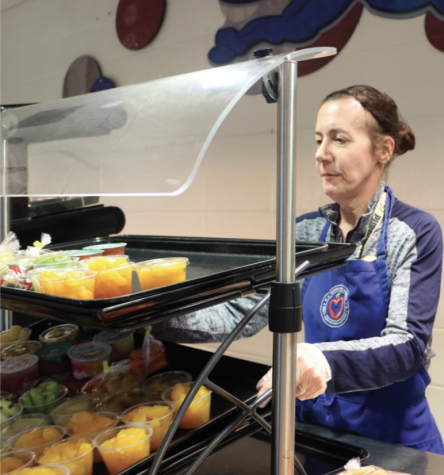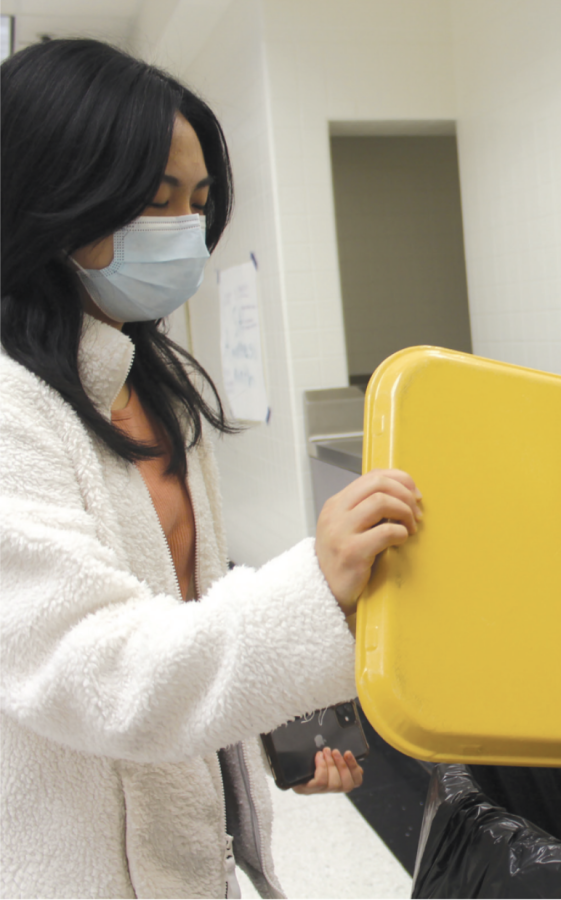After buying her lunch on a daily basis, sophomore Nancy Zhang said she noticed a disturbing amount of waste in the trash cans.
“Every day, I see unopened food or just half-eaten food in the trash as well as tons of plastic waste in the trash,” Zhang said. “I’ve seen full vegetable containers thrown away as well as three-fourths of an entree being thrown away. I’ve basically seen everything been thrown away at least once, which is a huge problem because greenhouse emissions are rapidly increasing and climate change is obviously occurring.”
What Zhang observed has been seen across the country. According to a study at Penn State University, American school cafeterias produce more food waste than other developed countries with food waste ranging from 27% to 53% of total food served. In fact, custodian Louise Bracken said the school has continued to produce an alarming amount of waste in cafeterias.
“There’s always been substantial food waste in the cafeterias,” Bracken said. “It’s always been lots of whatever they’re cooking that day. We always see a ton of sandwiches, pizza, pretzels, foods, salads—you name it (and) it goes in the trash.”
Zhang said she thinks the school’s requirement to include at least one vegetable or fruit for a free lunch has exacerbated the amount of food waste.
“When people take things that they don’t want to eat (in order to get a free lunch), they’ll likely throw it away. I’ve seen whole fruits and vegetables just thrown away in the trash without even being touched,” Zhang said.
Food service manager Holly Huepenbecker-Hull said while cafeteria workers try to minimize the amount of waste produced, there are challenges.
“We keep production records every day of everything that we make, and we write down the number of everything we have, everything we have left and if it’s a Blue Day or a Gold Day. The next time we go back to that same lunch we look to see how we had left over or if we were short,” Huepenbecker-Hull said. “That’s our first initial step to try to reduce waste is we first look at the numbers. We do the best we can, but obviously, without students ordering meals it’s kind of a guess.”
Previously, Huepenbecker-Hull said the school had programs for composting to reduce the school’s food waste.

Huepencker-Hull said, “Composting is something we would like to start back up again, but ever since COVID, we just haven’t had the staff to do it again.. It generates a little extra work for us just because we have to separate (compostable items) and then a company called Earth Mama would come to pick the compost up.”
Other than composting, the school implemented a food rescue program, where students could donate unopened packaged foods to people in need. Zhang said she hopes the school will reintroduce the program in the future.
“I think the school should place emphasis on saving leftover food or donating it. I think they should implement something like the (food rescue program) and tell people about it because a lot of people don’t know that it used to exist,” Zhang said.
Bracken said there was a decrease in food waste when the food rescue program was in place.
Bracken said, “There was less food thrown away when we had the program. I wish we could donate it all to the homeless people because there’s a ton of food in each cafeteria that gets wasted. It seems like we could be doing something better to help.”
Despite the benefits the program offered, Huepenbecker-Hull said the program was discontinued due to lack of interest and other logistic issues.
“Some kids didn’t participate because it could only be packaged items. Even if it is packaged and we could give it to the program, we ran into storage issues,” Huepenbecker-Hull said.

up fruits and vegetables to prepare for lunchtime. Vohs said
she prepares servings for students making sure there is an
adequate amount of food while limiting the amount of food
waste at CHS. (Zoe Tu)
Ultimately, Zhang said students can be more conscious of what they’re buying at lunch. “If you’re buying a lot of open food that will need to be thrown away, then maybe look at your tray and make sure you can finish everything on there. If you have food on there that is pre-packaged and that you don’t have to finish immediately, instead of throwing it away, just take it with you in your backpack,” Zhang said.
Bracken said she agreed with Zhang and said she hopes students will be more aware of the food waste they produce.
“I don’t know why (students) throw it away. If they’re not throwing it away, they’re throwing it in the cafeteria at each other,” Bracken said. “But I would tell (students) to eat what they buy and make sure their eyes aren’t bigger than their stomachs.”
While Zhang said eliminating food waste in the cafeteria would be difficult, she said it is still important to increase awareness of the amount of school food waste.
“We’re polluting the landfills and the ocean by using so much plastic packaging and wasting so much food. Carmel should really try to encourage students to not throw away as much food,” Zhang said. “We need to implement policies and ideas at our school to reduce food waste and protect the environment.”































![What happened to theater etiquette? [opinion]](https://hilite.org/wp-content/uploads/2025/04/Entertainment-Perspective-Cover-1200x471.jpg)













































![Review: “The Immortal Soul Salvage Yard:” A criminally underrated poetry collection [MUSE]](https://hilite.org/wp-content/uploads/2025/03/71cju6TvqmL._AC_UF10001000_QL80_.jpg)
![Review: "Dog Man" is Unapologetically Chaotic [MUSE]](https://hilite.org/wp-content/uploads/2025/03/dogman-1200x700.jpg)
![Review: "Ne Zha 2": The WeChat family reunion I didn’t know I needed [MUSE]](https://hilite.org/wp-content/uploads/2025/03/unnamed-4.png)
![Review in Print: Maripaz Villar brings a delightfully unique style to the world of WEBTOON [MUSE]](https://hilite.org/wp-content/uploads/2023/12/maripazcover-1200x960.jpg)
![Review: “The Sword of Kaigen” is a masterpiece [MUSE]](https://hilite.org/wp-content/uploads/2023/11/Screenshot-2023-11-26-201051.png)
![Review: Gateron Oil Kings, great linear switches, okay price [MUSE]](https://hilite.org/wp-content/uploads/2023/11/Screenshot-2023-11-26-200553.png)
![Review: “A Haunting in Venice” is a significant improvement from other Agatha Christie adaptations [MUSE]](https://hilite.org/wp-content/uploads/2023/11/e7ee2938a6d422669771bce6d8088521.jpg)
![Review: A Thanksgiving story from elementary school, still just as interesting [MUSE]](https://hilite.org/wp-content/uploads/2023/11/Screenshot-2023-11-26-195514-987x1200.png)
![Review: "When I Fly Towards You", cute, uplifting youth drama [MUSE]](https://hilite.org/wp-content/uploads/2023/09/When-I-Fly-Towards-You-Chinese-drama.png)
![Postcards from Muse: Hawaii Travel Diary [MUSE]](https://hilite.org/wp-content/uploads/2023/09/My-project-1-1200x1200.jpg)
![Review: "Ladybug & Cat Noir: The Movie," departure from original show [MUSE]](https://hilite.org/wp-content/uploads/2023/09/Ladybug__Cat_Noir_-_The_Movie_poster.jpg)
![Review in Print: "Hidden Love" is the cute, uplifting drama everyone needs [MUSE]](https://hilite.org/wp-content/uploads/2023/09/hiddenlovecover-e1693597208225-1030x1200.png)
![Review in Print: "Heartstopper" is the heartwarming queer romance we all need [MUSE]](https://hilite.org/wp-content/uploads/2023/08/museheartstoppercover-1200x654.png)



